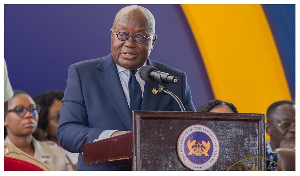The creative arts industry in Ghana receives the least of attention from policy makers and the public who have lost interest in the art hence killing the talents of many creative artists at the expense of the performing arts.
In Accra, the only place that comes to mind when creative artworks are needed is the Art Centre of the Centre for National Culture, where there is a pool of creative artists who mostly display their works to foreign nationals from Europe and America.
One creative artist who refuses to let the industry die out in its misery is sexagenarian scrap metal sculptor, Wanssi Massimo, who displays his sculptures in a pavement garden at Abelenkpe Junction, off the Olusegun Obasanjo Way in Accra.
Massimo, who hails from Nkonya in the Volta Region, believes art should be a consequential part of nature and his philosophy got him to secure the Garden Gallery which is under a tree with the greenery projecting the message his works convey.
Born on October 22, 1954, Wanssi Massimo calls himself an ‘Art Prophet’ because according to him, everything he touched from infancy, turned into art. Massimo, who has lived in many African countries including Tanzania and Togo says his quest in life is to demystify art as many Africans still relate it to sorcery.
Before opening up the Green Gallery in 2014, Massimo displayed his scrap metal sculptures in galleries across the country as well as exhibitions worldwide. He has participated in exhibitions in Togo, Nigeria, Benin and the United States of America where he believes the market is more in tune with the art than Ghana.
The ‘Art Prophet’ says Ghana has no art market, attributing the failure in that regard to the walls built around art works in the country which makes it difficult for people to see and express an interest.
“People cannot even get close to beautiful artworks created from the environment which are locked up in galleries. As soon as they take a peep through the glass windows, they refrain from entering with the notion that it is expensive. Art is priceless,” he said.
Massimo explains that the only market in the country for creative artworks are for expatriates who know the worth of art but, unfortunately, buy in seasons. He believes the appreciation level is very low in Ghana.
At his gallery, you will find beautiful fabrications made of scrap metal either shaped in human forms performing activities like drumming; or animal forms like the snake and giraffe. The giraffe, for example, has its mid-section made up of a small gas cylinder and its head made of some bolts and nuts.
Massimo chooses to leave the meanings of each sculpture to the eyes and mind of each observer to decipher according to their state of mind.
The scrap metals, he said, are handpicked by himself at the Agbogbloshie and Gallaway markets in Accra where most of the scrap metals from the city are disposed of. He then takes them to his workshop cum residence at Alajo where it takes days or weeks to mould depending on the inspiration he has.
He credits his wife of 33 years and four daughters for his inspiration as he always involves them in selection of what to be fixed where, with the aim of depicting natural situations that will create a story in the mind’s eye.
Wanssi Massimo started his display of sculptures at the pavement garden with one sculpture some two years ago. His motive was to observe the natural reaction of people who saw it; surprisingly, it was positive.
The responses got him to add other sculptures to the open-air gallery which led him to secure a license to legally occupy the pavement garden with his works. Aside beautifying the area, the gallery feeds himself and his family exclusively.
Massimo hopes to expand his gallery for a better capture of people’s imagination and is optimistic the upcoming artists will follow his lead to feed art to the people rather than wait for the people to come to art; which in Ghana, is almost impossible.
He cited an example of a government official who saw some of his sculptures and expressed interest. At the mention of the price, the Minister exclaimed: “Is this something edible?”
Massimo shuddered in awe at the attitude of policy makers regarding the creative art industry. He believes those in authority do not understand the creative arts hence their inability to give a listening ear to artists.
“They should advise us on what to advise them for them to listen to us for once,” he concludes.
As long as there are people like Wanssi Massimo, creative arts will live on.
Click on 'Photos' to see a display of Wanssi Massimo's sculptures.
Entertainment of Monday, 9 February 2015
Source: www.ghanaweb.com

















